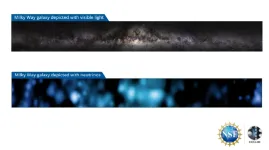(Press-News.org) Cyanotriazole compounds are fast-acting topoisomerase II poisons that can selectively and rapidly kill trypanosome parasites that cause Chagas disease and African sleeping sickness, according to a new study. Millions who live in Latin America and sub-Saharan Africa are at risk for trypanosomatid infections – pathogenic protozoan parasites that cause Chagas disease and human African trypanosomiasis (HAT), which are potentially fatal if not treated. Although treatments for HAT have improved in recent years, Chagas therapies remain limited and rely on lengthy regimens of toxic drugs. More effective, safer, and shorter-duration therapeutics for Chagas disease are critically needed. Here, Srinivasa Rao and colleagues performed an automated whole-cell high-throughput screening of the Novartis compound library – a database of drug-like molecules – to discover potential growth inhibitors for trypanosomatids. Through this analysis, Rao et al. identified a class of cyanotriazoles (CTs), which exhibited potent trypanocidal activity and led to rapid clearance of parasites both in vitro and in mouse models of Chagas and HAT. Using cryo-electron microscopy, the authors discovered that CTs selectively poison the parasite’s topoisomerase II – an essential enzyme in DNA replication – causing irreversible and lethal DNA damage. “Given their therapeutic efficacy, we are undertaking advanced preclinical profiling of further optimized CT analogs to identify clinical candidates with a suitable safety profile,” write Rao et al. In a related Perspective Ruslan Aphasizhev and Inna Aphasizheva discuss the study and its findings in more detail.
END
Cyanotriazole compounds can rapidly cure trypanosome infections in mice
2023-06-29
ELSE PRESS RELEASES FROM THIS DATE:
First 'ghost particle' image of Milky Way galaxy captured by scientists
2023-06-29
From visible starlight to radio waves, the Milky Way galaxy has long been observed through the various frequencies of electromagnetic radiation it emits. Scientists have now revealed a uniquely different image of our galaxy by determining the galactic origin of thousands of neutrinos — invisible "ghost particles" which exist in great quantities but normally pass straight through Earth undetected. The neutrino-based image of the Milky Way is the first of its kind: a galactic portrait made with particles of matter rather than electromagnetic ...
How the cat nose knows what it’s smelling
2023-06-29
COLUMBUS, Ohio – Scientists have found the secret to felines’ finesse at sniffing out food, friends and foes.
A complex collection of tightly coiled bony airway structures gets the credit, according to the first detailed analysis of the domestic cat’s nasal airway.
The researchers created a 3D computer model of the cat nose and simulated how an inhalation of air containing common cat food odors would flow through the coiled structures. They found that the air separates into two flow streams, one that is cleansed and humidified and another delivering the odorant quickly and efficiently to the system responsible for ...
Gullies on Mars could have been formed by recent periods of liquid meltwater, study suggests
2023-06-29
PROVIDENCE, R.I. [Brown University] — A study led by Brown University researchers offers new insights into how water from melting ice could have played a recent role in the formation of ravine-like channels that cut down the sides of impact craters on Mars.
The study, published in Science, focuses on Martian gullies, which look eerily similar to gullies that form on Earth in the Dry Valleys of Antarctica and are caused by water erosion from melting glaciers. The researchers, including Brown planetary scientist Jim Head, built a model that simulates a sweet spot for when conditions on Mars allow the planet to warm above freezing temperatures, ...
Chemists develop new method to create chiral structures
2023-06-29
RIVERSIDE, Calif. -- Some molecules exist in two forms such that their structures and their mirror images are not superimposable, like our left and right hands. Called chirality, it is a property these molecules have due to their asymmetry. Chiral molecules tend to be optically active because of how they interact with light. Oftentimes, only one form of a chiral molecule exists in nature, for example, DNA. Interestingly, if a chiral molecule works well as a drug, its mirror image could be ineffective for therapy.
In ...
The first neutrino image of our galaxy
2023-06-29
For the first time, researchers have produced an image of the Milky Way using neutrinos, which were observed with the IceCube telescope in the Antarctic ice. The neutrino image suggests that cosmic ray interactions are more intense in the center of our galaxy than once thought. The results are published in an article in the journal Science.
For ages, the view of our Milky Way galaxy has inspired awe, visible with the naked eye as a hazy band of stars that stretches across the sky. Now IceCube researchers are able to see the Milky Way using neutrinos – tiny, ghostlike ...
DNA organization in real-time
2023-06-29
Performing cutting-edge science requires thinking outside the box and bringing together different scientific disciplines. Sometimes this even means being in the right place at the right time. For David Brückner, postdoctoral researcher and NOMIS fellow at ISTA, all the above-mentioned things came into effect as he attended an on-campus lecture by Professor Thomas Gregor from Princeton University. Inspired by the talk, Brückner reached out with an idea: to physically interpret the specific data sets Gregor presented. Now, the results of their collaboration are published ...
JDR Clinical & Translational Research receives first ever Impact Factor™
2023-06-29
Alexandria, VA – The International Association for Dental, Oral, and Craniofacial Research (IADR) and the American Association for Dental, Oral, and Craniofacial Research (AADOCR) announced today the JDR Clinical & Translational Research (JDR CTR) has received its first Journal Impact Factor™.
JDR CTR has earned a Journal Impact Factor of 3.0, with an Eigenfactor™ of 0.00148, an Immediacy Index of 0.5, and 786 total citations in 2022. This represents a significant achievement and a huge milestone in JDR CTR’s history, which was launched in 2016.
“JDR CTR’s new Impact Factor marks the culmination of years of commitment ...
Journal of Dental Research announces New Impact Factor™
2023-06-29
Alexandria, VA – The International Association for Dental, Oral, and Craniofacial Research and American Association for Dental, Oral, and Craniofacial Research announced the Journal of Dental Research (JDR) 2-Year Journal Impact Factor™ is now 7.6, ranking it #3 of 91 journals in the “Dentistry, Oral Surgery & Medicine” category.
The JDR 5-year Journal Impact Factor™ is also 7.6, with an Immediacy Index of 1.1 and an article Influence score of 1.638. The JDR once again ranked #1 of 91 journals in total citations, with a total of 25,849 in 2022, and ranked #3 in Eigenfactor with a score of 0.01345.
The 2-year Journal Impact Factor™ is defined ...
NASA’s Webb identifies the earliest strands of the cosmic web
2023-06-29
Galaxies are not scattered randomly across the universe. They gather together not only into clusters, but into vast interconnected filamentary structures with gigantic barren voids in between. This “cosmic web” started out tenuous and became more distinct over time as gravity drew matter together.
Astronomers using NASA’s James Webb Space Telescope have discovered a thread-like arrangement of 10 galaxies that existed just 830 million years after the big bang. The 3 million light-year-long structure is anchored by a luminous quasar – a galaxy with an active, supermassive black hole at ...
Improvement to CRISPR gene editing could make it more effective
2023-06-29
DURHAM, N.C. – CRISPR gene editing is a breakthrough that has been used to treat diseases such as sickle cell anemia, leukemia and genetic disorders, but it has challenges that limit its broad utility.
Identifying the root of those issues led a research team at Duke Health to find an improved approach to gene editing that expands its functionality.
In work appearing online June 29 in the journal Cell Chemical Biology, the researchers lay out a new way to identify diverse CRISPR RNA variants that can specifically home in on challenging areas of DNA to target for editing. The new approach opens up more of the genome for editing, ...





